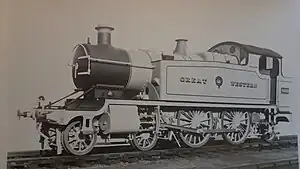| GWR 4600 Class | |||||||||||||||||||||||||||||||||||||||
|---|---|---|---|---|---|---|---|---|---|---|---|---|---|---|---|---|---|---|---|---|---|---|---|---|---|---|---|---|---|---|---|---|---|---|---|---|---|---|---|
 GWR 4-4-2T No. 4600 | |||||||||||||||||||||||||||||||||||||||
| |||||||||||||||||||||||||||||||||||||||
| |||||||||||||||||||||||||||||||||||||||
| |||||||||||||||||||||||||||||||||||||||
| |||||||||||||||||||||||||||||||||||||||
The 4600 Class was a 4-4-2T steam locomotive built by the Great Western Railway in 1913. It was one of the GWR standard classes with two outside cylinders.
It was designed as light suburban locomotive, based on the successful 4500 class 2-6-2T engines. Compared with these, it had larger (and fewer) coupled wheels, intended to allow higher speeds with local trains. The only example built spent most of its career in the Birmingham area, and was not considered a success. The limited adhesion and restricted tank capacity meant that it did not improve on the 4500 class, and the larger 2-6-2T classes handled the suburban traffic better. It was moved to western Wales in 1918 for use on the lines to Pembroke Dock and Neyland. It was withdrawn in 1925 and scrapped.[2][3][4]
Notes
- ↑ Champ (2018), p. 319.
- ↑ Haresnape & Swain (1976), pp. 94–95.
- ↑ Holcroft (1957), p. 137.
- ↑ le Fleming 1962, p. J51.
References
- Allcock, N. J.; Davies, F. K.; le Fleming, H. M.; Maskelyne, J. N.; Reed, P. J. T.; Tabor, F. J. (1968) [1951]. White, D. E. (ed.). The Locomotives of the Great Western Railway, part one: Preliminary Survey. Kenilworth: RCTS.
- Champ, Jim (2018). An Introduction to Great Western Locomotive Development. Barnsley: Pen & Sword Transport. ISBN 978-1-4738-7784-9. OCLC 1029234106. OL 26953051M.
- Haresnape, Brian; Swain, Alec (1976). Churchward locomotives : a pictorial history. London: I. Allan. ISBN 0-7110-0697-0.
- Holcroft, Harold (1957). An Outline of Great Western Railway Locomotive Practice. London: Locomotive Publishing Co Ltd.
- le Fleming, H.M. (February 1962). White, D.E. (ed.). The Locomotives of the Great Western Railway, part nine: Standard Two-Cylinder Classes. RCTS. ISBN 0-901115-37-1. OCLC 655827210.